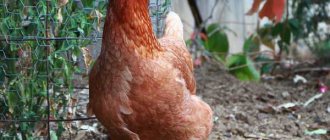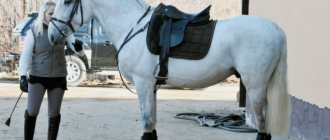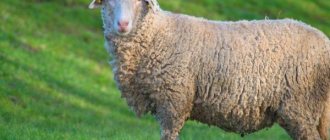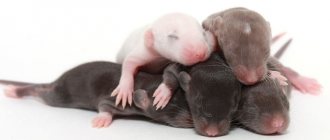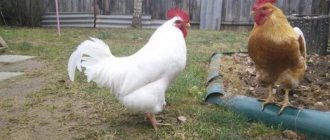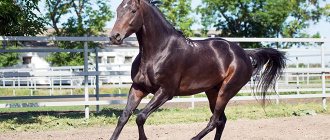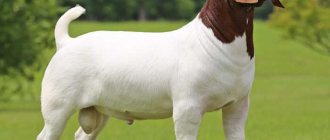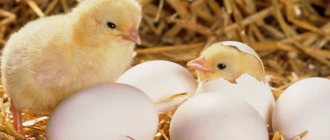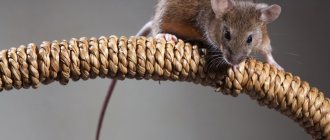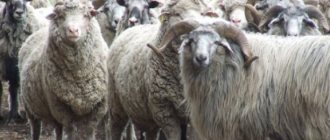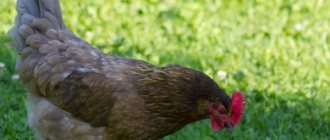Over the past half century, scientists have created many hybrids of poultry of a universal direction. They are popular among private farm owners because they produce eggs and meat at the same time. Master Gray chickens are a meat-egg cross, characterized by their undemanding requirements for feed and care. For those who are currently choosing between broilers and layers, it will be useful to learn more about birds from Hubbard.
Rooster master gray
a brief description of
Master Gray is positioned by its creators as a cross between meat and egg. By 6 months, hens can weigh 3.5-4 kg, and roosters can weigh up to 7 kg! At the same time, chickens begin to lay eggs at the age of three and a half months. They say that in a year you can get up to 300 eggs from one chicken, as from representatives of the best egg breeds.
According to farmers, the meat is very tasty, without excess fat, dense but tender. The taste is similar to domestic chickens, which is appreciated in the market. The large yield of dietary white meat from the sternum makes the breed suitable for baby food. Large and meaty legs will also find their fans.
In the photo - the gorgeous Master Gray from the farm of Dmitry Kudlaenko (Ukraine)
The eggs are large, weighing 65-70 g, with a cream or brown shell. Farmers note that the promised 300 eggs per year are unlikely to be produced, but 200 eggs are realistic. Perhaps “sterile” conditions in poultry farms are required for maximum egg production. But the main goal of breeding this cross was to obtain unpretentious and hardy chickens for keeping in private farms.
Where to buy chickens in Russia?
You can usually purchase representatives of this breed in a large city. Local breeders are not the best choice of supplier. Turning to specialized companies is safer. In Russia there are numerous poultry farms where various breeds of chickens similar to this cross are bred:
- Orlovsky Dvorik LLC , which is 1 km from the Moscow Ring Road along the Yaroslavskoe Highway, official website of the company https://www.orlovdvor.ru, contact numbers;
- Farm " Golden Feathers " Moscow 20 km from the Moscow Ring Road along Nosovikhinskoye Highway. Tel., +7 (916) 651-03-99 from 10-00 to 21.00;
- Personal plot of land " Ecofarm " Tel. +7.
- Hatchery LLC Address: 142305, Moscow region, Chekhov district, Chekhov-5 city, Sergeevo village Tel: +7 (495) 229-89-35.
However, Master Gray is not easy to find in Russia. For the most part, the breed is bred by poultry farms in Ukraine. Breeding of the following breeds is widespread in Russia: Orpington, Rhode Island, Moskovskaya, Poltava clayey, Plymouth rock, Sussex. In Ukraine, chickens can be found in almost every poultry farm.
Appearance
“Gray” means “gray” in English. Not surprisingly, the breed has a very beautiful gray and white coloring. The plumage alternates gray and white feathers. At the same time, there is a wide darker necklace around the neck, dark edges of the wings and tail. The back and belly are lighter, the pattern is faintly noticeable. Bright red earrings and a comb add a touch of elegance. The birds have a very beautiful appearance, which also makes them desirable in private backyards.
The physique is large and massive. Legs are powerful and of medium length. The bird looks strong and strong. Well-developed muscles and strong bones are designed to carry a heavy, powerful body.
Chicks at one day old are pale yellow, almost white in color. They have a gray spot on the top of their head, and the tips of their wings are dark.
Foxy Chick
Representatives of the Foxy Chick (or Red Bro) cross are very similar in build to Grays. This is actually the same parent breed line as the Master Gray. But their color is fiery red, which is reflected in the name (“Fox” means “fox” in English).
These are also meat and egg chickens with excellent performance. Breeders believe they are larger than Master Gray and lay better.
Red Bro can withstand both cold and snow without problems.
But the mysterious Master Gris (or Gris ) is nothing more than another interpretation of the breed: in this case we are talking about the French language (Gris French - Gray).
Photo
In the first photo, a rooster of our breed appears in all its glory, in a classic pose on a fence:
In the next three photographs you will see chickens with a reddish tint. They are also called by RedBro:
Content
Master Gray chickens do not require any special conditions for this plus of the breed. They can be kept like regular domestic chickens. You can do without expensive feed additives and super-duper feeders, drinkers, and poultry houses. Grays can be kept on the floor or in cages. They behave calmly when grazing.
From the first days, chickens can be fed with starter feed. It’s great if it’s complemented with green grass and vegetables. At about two weeks of age, they can safely eat both wet mash and food scraps. Basically the requirements are the same: the presence of fresh water, coarse sand or fine gravel to improve digestion. For strong bones and egg shells, add skim milk, chalk, and shells to the food. And ash-sand baths for the “personal hygiene” of chickens.
Those who have already kept such chickens note that they first grow upward. And already at the age of 5-6 weeks they begin to grow in width, reaching the usual massive appearance of an adult bird.
Heating is not required in the poultry house; conventional insulation is sufficient. The bird tolerates cold and heat well. But still there should be no drafts. By covering the floor of the poultry house with a thick layer of shavings, straw, and sawdust, you can achieve a temperature of at least +2° even in the coldest weather. This is explained by the fact that the lower layers gradually decompose and release heat, which is quite enough for the comfortable keeping of chickens. Under such conditions, chickens lay eggs even in winter.
Feeding
Adults
The diet for Master Gray chickens is standard. They need round-the-clock access to clean water, fine gravel, and coarse sand.
Birds should be given grains, vegetables, meat and bone or fish meal, fresh herbs, corn, chalk or crushed shells. They should be fed three times a day - they are fed grains in the morning and evening, and wet mash in the afternoon.
In winter, be sure to add grass meal to your bird's diet.
When feeding poultry for meat, purchase for Master Gray factory-made feed for broiler meat, high in protein and carbohydrates. This way they will gain weight faster, but will not start laying eggs.
Chickens and young animals
One-day-old Master Gray chicks are fed starter feed with the addition of fresh herbs, chopped boiled eggs or meat. Vegetables are gradually introduced into the diet.
From 14 days of age, wet mash of crushed grain and steamed buckwheat are added. From 6 weeks, ground wheat and barley are given. Mandatory feedings: low-fat cottage cheese, skimmed milk and chalk.
At first, babies are fed every couple of hours, then 5-6 times a day. From two months, chicks are fed three times a day.
When raising Master Gray chickens, the young should not be allowed to starve, otherwise the chicks will grow up defective.
Up to two weeks, feed consumption per 1 kilogram of chicken weight gained is 1.3 kg, up to 35 days - 1.7 kg, and up to 63 - 2.3 kg.
Adult chickens and chicks must have round-the-clock access to clean water; be sure to change it when it gets dirty.
Master Gray: chicken breed (description)
Raising chickens is a profitable business. But before you buy chickens, you should think about what you want to get from them: eggs, meat, or both. And depending on the decision made, purchase birds of meat, egg or meat-egg breed.
But there are also crosses, which are also very profitable to grow. Prominent representatives are Master Gray chickens (Master Griz). This species is interesting because it gains weight like broiler chickens, and the egg production is like that of the best laying hens.
Diseases
Despite the good immunity of birds, Master Gray chickens sometimes get sick. The most common disease conditions of the breed:
- Colonization of the body by parasites. Ticks attack the skin, feather eaters destroy the integrity of the plumage, and helminthic infestations affect the entire body. Symptoms of the presence of parasites are similar to those of infection. The chickens stop eating, go bald, and look lethargic. Treatment is carried out by a veterinarian. It is aimed at eliminating parasites and including vitamin supplements in the chicken’s diet to quickly restore its body.
- Vitamin deficiency is a condition that occurs as a result of an imbalance in the diet of chickens. It manifests itself in the form of apathy and lethargy in birds. Treated with feed vitamin supplements.
- Infectious and bacterial lesions of birds. If vaccination is untimely and sanitary and hygienic standards for maintaining the chicken coop are violated, individuals may experience illness caused by viral or bacterial agents.
Description and characteristics
These chickens are characterized by gray-white plumage, a darker shade on the neck, tail and wing tips. Against the background of the light body, the beard and comb of a deep red color stand out effectively. In terms of physique, purebred chickens Master Gray are a breed of chickens, the description of which is significantly different from other crosses: the birds are much taller, the body is longer, the back is wider, and the limbs are powerful. Wings of medium length, pressed to the body. The tail feathers are small even in males, which is typical for broiler breeds of chickens. A leaf-shaped comb with teeth.
Important! Thoroughbred Master Gray roosters must be kept in a heated coop in winter, otherwise their combs will freeze.
The hens of this species have a body almost as large as that of roosters, and are very similar to the figure of females of the broiler variety. The limbs are strong and powerful, bright yellow in color, and the claws are light. The bone skeleton of this poultry is stronger, since the body weight of crosses is greater. The chest is wide and well developed, so after slaughter a lot of delicious, tender white meat is obtained from each carcass.
The weight of an adult male reaches 6.5-7.2 kg, and females - 3.7-4.1 kg.
The head of chickens is smooth, red in color, with white bristles. Large eyes have an orange iris, but the beautiful appearance of Master Gray roosters and hens is better seen in photographs.
Master Gray chickens
Newborn chicks have white down with a slight yellow tint, but there are already darker feathers at the tips of the wings, and a gray spot on the head. After a few days, the young animals begin to grow baby feathers, the color of which is not as rich as that of adults, but already the same as required by the breed standard.
The character of the crosses is calm, even roosters are not known for being pugnacious, so they get along calmly with other inhabitants of the poultry yard. In addition, the Master Gray breed is distinguished by its patience, calm attitude towards living conditions, and calm attitude towards changing owners. These birds are not timid; laying hens do not mind stressful situations, after which other breeds stop laying eggs or lose their appetite. With a properly selected diet and proper care, laying hens lay at least 200 eggs per year, and for record holders this figure can reach 290-300 eggs per year. The weight of the egg at the beginning of egg production is about 60 g; in older birds the weight reaches 70 g.
Important! When buying chickens, you should remember that young animals of the Master Gray breed never have a colored color.
Chickens of this breed are considered early maturing, since they begin laying eggs at 4 months and also gain good body weight. Therefore, Master Gray crosses are beneficial for breeding not only in private households, but also in poultry farms.
Laying hens of this species do not have maternal instinct, but this does not matter when breeding this breed, because their offspring will not have all the characteristics inherent in their parents. Therefore, it is possible to breed offspring from eggs laid by Master Gray hens, but they will not meet the standards.
Features of breeding chickens Master Gray
It is easy to raise the offspring of these poultry from eggs; all you need is an incubator and eggs from the manufacturer.
For your information! Another plus is the high percentage of hatchability of young animals (above 95%).
Newborn chickens have increased immunity, so they do not die during transportation. The survival rate is above 97%. The main thing is the correct conditions for keeping and feeding the young animals. If the diet is compiled according to all the rules, then within a couple of weeks after birth the chicks can weigh more than 500 g.
Master Gray young
Chickens should always have fresh food in their feeders because they have an increased appetite. And this is natural, because by 4 months the young gain about half the weight of an adult.
What diet should chickens have? The daily menu for chickens up to 45 days can be composed of:
- ground wheat grain (and other grain crops);
- chopped greens;
- vegetables;
- cottage cheese;
- eggs
Adults are unpretentious in their diet, so they are fed approximately the same as other breeds of broiler chickens.
Important! There are practically no problems in breeding this breed; the main thing is to keep this bird in a warm room in winter, where it is not damp and there are no drafts.
Character
The calm and submissive disposition of these chickens can be considered an advantage. Representatives of this species practically do not organize cockfights, rarely quarrel and easily find a common language with other inhabitants of the poultry yard.
Thanks to their patient nature, they can withstand any conditions and easily tolerate a change of owner. These crosses cannot be classified as timid - they are practically imperturbable, and no worries can affect the productivity indicators and behavior of the birds.
Advantages and disadvantages of the breed
The advantages of this type of poultry are obvious:
- early maturity, the beginning of egg production from 4 months of age;
- high rates of meat and egg productivity;
- calm disposition, nothing affects productivity;
- beautiful appearance.
This species has practically no disadvantages, but it is worth remembering that it will be more difficult to breed this species at home, since you will have to go to Hungary to get eggs for the incubator, where the supplier closest to Russia is located.
Molting and break in egg production
It is impossible to say exactly what season the molting will begin - a lot depends on what time of year the feathered beauties were born and in what conditions they live. Most often, the beginning of molting occurs in mid-to-late autumn, but for some laying hens this process drags on throughout the winter.
The advantage of these black plumes is that even during this difficult period they do not stop laying eggs. Therefore, it is especially important to monitor the balance of nutrients in the diet and use additional vitamin supplements and fish oil.
Breed characteristics
Master Gray is a cross, which is why breeding them on a private farm is impossible. They are characterized by large mass and good egg-laying ability. Unlike other birds, this breed has a gentle disposition, goodwill, and obedience. This colored broiler was bred by the Hungarian company Hubbadr, which has French and American branches.
The description of Master Gray chickens indicates their good productivity, as well as attractive appearance.
The individual has a large body build and massive, medium-sized limbs. The feathers of the laying hen and the cockerel are gray, pockmarked or shell-colored. The color of the feathers is predominantly gray, which is why the breed is named accordingly. The variegation of the plumage is achieved by a chaotic alternating arrangement of gray and white feathers. A more contrasting dark pattern is visible on the neck and wings. The comb and earrings on the bird's head stand out in red or bright red.
The differences between a laying hen and a rooster are visible to the naked eye. The female specimen is smaller, its weight is about 4000 grams, the male specimen is larger, its weight is 6000 grams. The laying hen's body has a round shape, a lush convex chest and belly. The cockerel is elongated in body shape, it has a toned tummy and a not too rounded chest. Chickens lay eggs as early as three months of age. Over a period of 12 months, one bird can produce approximately 300 eggs. Master Gray meat has a pleasant taste, it is characterized by tenderness, density and lack of fat.
The breast of this bird is used as a dietary product. The eggs of these representatives are large, weighing approximately 70 grams. This cross is famous for its unpretentiousness, productivity, endurance, and the ability to grow in the private sector. Chickens of this breed are characterized by good survival rate, which other birds cannot boast of.
Breeding history
This breed was obtained by specialists from the international company Hubbard. Its research centers are located in France, the USA, and Germany. Branches are present in many countries, including Hungary - this is where chickens come to Russia. Which breeds formed the basis of the cross are kept secret. From his parent stock he inherited:
- unpretentiousness;
- fast growth;
- high productivity of meat and eggs.
The name reflects the peculiarity of the color (“grey” - “gray”).
Advantages and disadvantages
The Master Gray breed is characterized by a lot of advantages, the main ones of which are the following:
- high percentage of chicken survival - about 98%;
- endurance;
- lack of fearfulness;
- low demands on living conditions;
- large body weight;
- good egg production;
- high quality meat;
- affordable price.
The only disadvantage of the breed is its slow growth, however, compared to the quality of the meat, this disadvantage seems insignificant.
Farmer reviews
Oksana , 38 years old, Saratov region:
“When I read the reviews on the farmers’ website, I bought laying hens last year for meat. We were pleasantly pleased with the growth rate and docile nature of the birds. One-year-old individuals can already be used for their intended purpose.”
Svyatoslav , 53 years old, Almaty:
“Master Gray chickens are the optimal solution for unfavorable and unstable weather conditions. I have been raising these birds for 10 years and am pleased with the results.”
Chicken coop
To keep this breed of chicken, the owner should build a chicken coop, which will have standard equipment inside. The room must be dry, warm and clean. If individuals are kept in cages, they quickly gain weight. This type of keeping makes it possible to place twice as many birds in a small area as they can be raised with the floor option.
The optimal temperature for Master Gray chickens is considered to be from 2 to 30 degrees Celsius. You should not build heating in the chicken coop; instead, it is better to lay straw, sawdust or peat on the floor. To avoid excess moisture, as an option, you can sprinkle a little lime under the bedding layer. For a normal microclimate in the chicken coop, it is necessary to regularly ventilate the room, but avoid drafts.
High humidity in a chicken coop means the birds can become infected with infectious diseases, and a draft is a step toward catching a cold.
To house two dozen chickens of this large-bodied breed, you will need 10 m2 of space. It is worth building perches indoors at a height of 0.5 meters, as well as a ladder for easy climbing. The height of the nests should be no less than 0.4 meters, and ladders should be built nearby. The dimensions of the nests should be 0.4 by 0.4 meters. Also, do not forget about feeders, drinkers, containers with sand and ash where the chickens will bathe.
Nutrition
The Master Gray chicken breed does not require any special food. If the purpose of breeding is not fattening, like broilers, then there is no need to give them carbohydrate and protein feed. In turn, representatives of the egg trend need food with large amounts of vitamin E, calcium, and protein. They need to be fed 3 times a day in winter and twice in summer. If the chicken is kept in a cage, then the number of meals should not be reduced in the summer.
Grain should be given in the morning and evening; daytime food should contain greens, vegetables, and a wet mash that contains bran and bran. If there is an area of green grass nearby, you can release the birds to graze there. The diet should also include food of animal origin, namely bone and meat and bone meal, and fish meal.
To strengthen the shells of chicken eggs, you can add a mineral supplement, chalk, shellfish or crushed egg shells to the feed.
The basis of the diet for chickens should remain grains, greens and vegetables. Chicks that are less than a month old should be fed high protein foods. For example, it could be hard-boiled eggs, meat or fish. They should also be given greens or ready-made chicken feed. It is worth remembering that when feeding babies with Master Gray compound feed, they will rapidly gain weight, but will not lay eggs.
In addition to protein food, chickens should be given grain. From the first days of babies' lives, you can feed them boiled millet mixed with eggs. After one and a half months of age, they can be fed ground wheat or barley. The amount of food for the little gray will increase as the chick gets older. For each kilogram of weight gained, feed is needed in the following volume:
- up to 2 weeks of age – 1300 grams;
- from 2 weeks to 4 weeks – 1700 grams;
- from 4 weeks to 8 weeks – 2300 grams.
Features of chicken care
Master Gray chickens can be kept on the floor or in cages. The first option is suitable for farmers who have a spacious barn and walking area. Large birds need a lot of space. The recommended population density of the poultry house is 2 individuals per 1 m2.
Arrangement of the barn
Cage keeping involves raising chickens without walking. In this case, the birds are limited in movement, so they gain weight faster, but the quality of the meat decreases - the carcasses contain more fat.
Chicken coop requirements
Those who want to raise Master Gray chickens in their backyard will have to build a warm poultry house. In the northern regions and the middle zone it is very cold in winter, so it is necessary to provide for the possibility of heating the barn. The recommended temperature for cross-country is +8…+26 ºС.
The chicken coop should be located on an elevated place. Be sure to have a window to allow natural light into the room. Laying hens are kept on a thick bedding of straw or a mixture of sawdust and peat. As it gets dirty with droppings, it is turned over. Once a month, it is recommended to lay a layer of fresh bedding material on top of the old one.
Representatives of the Master Gray breed cannot fly due to their heavy weight. Perches for them are installed at a height of 60 cm. For ease of ascent and descent, gentle stairs are provided. For 1 adult bird, 40 cm of pole length is allotted.
For laying hens you will need nesting boxes - 1 piece for 3-4 birds. It is advisable to equip them with egg receptacles, otherwise massive and clumsy chickens will crush the shells. A feeder, containers for gravel, shell rock and a drinking bowl are installed on the floor.
Ventilation in the chicken coop
Farmers pay special attention to maintaining the correct indoor microclimate. The health and productivity of birds depends on this. It is important to ensure good air exchange. When droppings decompose, ammonia and hydrogen sulfide vapors are released; due to their high concentrations, chickens' immunity is reduced. Poor ventilation often causes the development of respiratory system diseases.
Attention! Ammonia vapors that accumulate in the air cause night blindness in chickens.
Walking yard
Daily walks have a beneficial effect on the productivity of poultry. Outside, birds get a dose of ultraviolet light, peck at fresh greens, and look for worms and beetles. A walking area is installed next to the poultry house and connected to it by a manhole. Master Gray laying hens do not need a high fence - their wings are poorly developed. A trough with a sand-ash mixture for bathing chickens is installed on the territory of the pen.
Aviary for chickens
With the onset of spring, birds spend most of the day walking. They leave the coop after morning feeding and return home in the evening. In winter, chickens also need to be outdoors, but walks should not be long. When the thermometer drops to -5 ºС or a strong wind blows, it is better for the birds to stay in the house, otherwise they will freeze their crests.
How does shedding affect productivity?
Molting begins in October. Old feathers fall out and new ones grow back. At this time, the laying hens develop bald spots on their bodies, which makes them cold. Changing a feather causes a blow to the body's immune system, since most of the nutrients are spent on the formation of a new cover. During this period, chickens need protection from dampness, drafts and adequate nutrition. The diet of birds is enriched with vitamins and microelements.
Reference. During molting, egg production drops by about 40%. Productivity is restored after 2 months.
Feeding recommendations
Representatives of the Master Gray breed will fully reveal their productive qualities if they are provided with adequate nutrition. Birds do not have to be fed with expensive feed and premixes, like broilers. The basis of the diet is grain mixtures consisting of millet, millet, barley, buckwheat, and corn.
Attention! Master Gray chickens should not be overfed - they are prone to obesity.
In addition to grain, birds are given beans - peas, lentils, which contain protein. Vegetables and greens are sources of vitamins. Laying hens happily eat carrots, fodder beets, cucumbers, and pumpkins. In summer, poultry eats grass most of the day - shoots and leaves of nettle, dandelion, alfalfa, and plantain. Garden owners provide tops to birds.
Chickens love sprouted grains
The birds' menu includes useful additives that serve as a source of minerals - chalk, yeast, sunflower cake. To keep the shell strong, birds must receive shell rock, which contains a lot of calcium. To replenish the lack of vitamins in winter, birds are given grain sprouts and grass pellets.
The frequency of feeding depends on the time of year. In the summer, laying hens are given grain in the morning and evening, because most of the time they are outside and there they find food for themselves - worms, slugs, weeds. In winter, laying hens are fed 3 times a day - at lunchtime, farmers treat them with wet mash. They add vegetables, herbs, bone meal, and chalk. The diet of chickens is enriched with fish oil to prevent rickets.
Disease Prevention
With good care, Master Gray chickens do not get sick; they are famous for their stable immunity. If a farmer does not follow the recommendations for feeding and caring for poultry, the livestock may suffer from parasitic diseases, vitamin deficiencies and colds.
Unsanitary conditions in a chicken coop often cause birds to become infected with mites, which infect the birds’ paws. This disease is called knemidocoptosis and is accompanied by the appearance of ugly bumps on the legs. The pathogens gnaw passages in the skin and lay eggs there, which causes anxiety to the laying hen.
A sick chicken sits to the side and fusses
Dampness and draft are the worst enemies of poultry. In such conditions, chickens weaken and become vulnerable to viral and bacterial infections - mycoplasmosis, salmonellosis, pasteurellosis. Daily inspection of the livestock will help you see in time that the hen is sick. Signs of illness:
- lethargy, depressed appearance, loss of appetite;
- the bird sits to the side, ruffled, eyes half-closed;
- thirst;
- discharge from the eyes - purulent or foamy;
- cough, wheezing;
- blanching of the ridge;
- impaired coordination of movements;
- diarrhea - white, green, foamy, with blood.
Attention! Having discovered such symptoms, the farmer must isolate the hen and invite a veterinarian. There is no time to delay - contagious diseases spread quickly.
Walking area
For chickens to walk, you can build manholes that should be closed at night. Master grays do not fly, so they can walk in the yard without a fence. In winter, when the outside temperature drops below -5 degrees, you should not walk birds. According to breeders, crosses can only be kept in cages. However, if there is an area with various herbs on the territory, then it can be fenced off so that chickens pluck the greenery there.
For 10 birds, approximately 16 m2 of territory is required. When choosing a place, you should give preference to one that is removed from close human attention. It is also necessary to build a shade so that the birds do not get hurt on a hot day. When walking, fresh water must be constantly available in the bird's access area.
Breeding
Master Gray chickens lack maternal instinct. Therefore, the laying hen will never sit on the eggs. However, even with an incubator, raising poultry from existing eggs of this breed will be impractical. In the second generation, these chickens completely lose the productivity of the parent. This happens due to the splitting of the cross along breed lines.
To breed this breed of chickens on a private farm, it is worth buying hatching eggs from specialized nurseries. It is also a good option to buy chickens at any age.
The young animals are not afraid of transportation, and if the thermal regime and a sufficient amount of fresh air are observed, then 98% of the babies will survive.
In the brood of chickens of this breed, there are quite small representatives that are able to grow quickly and gain weight. At two weeks of age, the chick weighs about 0.5 kg. Chicks fledge slowly, so they need constant control of the thermal regime. After birth and for two weeks, chickens should be provided with a room temperature of 30-32 degrees.
The main rule for successfully raising chickens of this breed is correct feeding of the birds. For rapid growth, they should be supplied with proteins and minerals. If there is a lack of these components in Master Gray chickens, an anomaly in development begins. For the first 5 days from birth, babies should be fed boiled eggs and corn porridge. It is also worth observing the frequency of feed dispensing; it should be done every 120 minutes.
It is worth gradually adding cottage cheese, chopped herbs, vegetables, and ground grains to the chickens’ diet. At this time, it is worth feeding the chicks every 3 hours. At the age of 1.5-2 months, young animals can be switched to the diet of adult birds
The incidence of master gray is uncommon, but the owner should think about preventive measures in advance. Chickens should be vaccinated against fatal chicken diseases.
Also, do not forget about the cleanliness of chicken coops, as well as their treatment from helminths and skin insects. To disinfect a chicken coop, you should use creolin, caustic, and formaldehyde.
If you notice that one of the birds is eating little, diarrhea or going bald, then it should be examined immediately. Often such chickens suffer from parasites. The chicken mite and the fluff eater pose a danger to birds.
Age problems and herd replacement
Despite the fact that laying hens show high results in their activities, their productive period is very short. Only in the first year after the start of oviposition can a record number of eggs be obtained.
Next year, egg production rates drop sharply by 30-40%. Therefore, planned replacement of the herd is recommended immediately after the end of the peak production period.
Diseases.
Even during the period of breeding work to create this hybrid, scientists made efforts to ensure that the birds rarely got sick and were resistant to various infections. Therefore, diseases attack birds extremely rarely.
But we still must not forget about preventive measures. Strong immunity does not save birds from attacks by parasites and vitamin deficiency, which sometimes develops into attacks of cannibalism, especially during the molting period.
The destruction of parasites must be done regularly, as well as the premises in which the birds live. If it is difficult to protect yourself from parasites, then vitamin deficiency can be prevented. It’s enough just to balance the diet and regularly replenish the brood hens’ need for nutrients.
What are the reviews?
